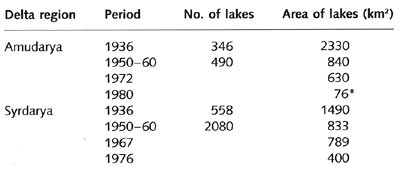Please put an active hyperlink to our site (www.rusnature.info) when you copy the materials from this page
Environmental problems of Northern Eurasia
The Aral Sea
<<< Climatic Effects | Environmental Problems Index | Environmental
Problems in Irrigated Areas >>>
Delta Areas
The delta areas of the Amudarya and Syrdarya rivers have been transformed due to the
lack of water, adversely affecting flora, fauna, and soils. Reduced flows of water have
resulted in the fragmentation of lakes in the deltas and a decline in the overall area
occupied by lakes (Table 22.5).

Table 22.5 Changes in the number and area of natural lakes in the
Amudarya and Syrdarya deltas (1936-80)
The native tugai forests have been severely degraded as ground water levels in the
deltas have fallen (by 10-15 m in some places) and floodplains are no longer inundated.
The tugai is characterized by extremely rich floral plant communities, containing 576
higher plant species of which 29 are endemic to Central Asia (Chapter 12; Glazovsky,
1995b). Fifty-four of these species were on the verge of extinction in the mid-1990s.
Several species of waterlily and fern had already disappeared.
These areas were also economically important, providing grazing for livestock, and
opportunities for hunting, trapping, and reed harvesting for local industries (UNEP,
1992a). About 420 000 ha of hay meadows were used in the Amudarya delta in 1960, but by
the end of the 1980s just 70 000 ha remained and their productivity had been reduced by
the increasing salinity of the soils. Commercial hunting and trapping has virtually
disappeared as conditions in the deltas have become unfavourable for such game as hog and
muskrat. The lower reaches of the Syrdarya yielded 70000-230000 muskrat skins during the
1950s, but hunting ceased in 1978. In the 1970s, up to 50 000 muskrat skins were taken
each year in the Amudarya delta, but hunting stopped in the early 1980s.
Deterioration of the habitat has harmed many other faunal populations. The Bukhara deer
has virtually disappeared from its degraded tugai habitat and most of the deltas'
migratory bird populations no longer visit these areas as habitats have changed and food
sources, such as the Aral Sea's fish population, have been depleted (Novikova and
Zaletayev, 1985). The number of bird species commonly found in the lower Syrdarya has been
reduced from 173 in 1960 to 38 in thirty years (Glazovsky, 1995b).
One positive aspect of these ecological changes from the human viewpont is a decline in
the range of the Asiatic Migratory locust. The reedbeds of the Amudarya delta were
formerly one of the most important permanent breeding centres of this locust that
represented a significant pest to irrigated cropland during outbreak years, but the
decline in reed area has dramatically reduced their breeding capability. However,
conditions have become more favourable for the Italian locust which has replaced the
Asiatic Migratory locust as a periodic threat to the cotton crop (Latchininsky and
Gapparov, 1996).
<<< Climatic Effects | Environmental Problems Index | Environmental
Problems in Irrigated Areas >>>
Contents of the Aral Sea section:
Other sections of Environmental Problems of Nortern Eurasia:
|
|